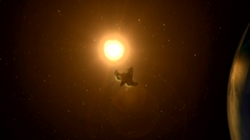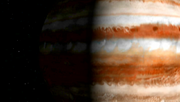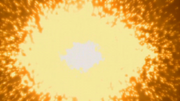
Sol from Earth orbit, circa 1002262.
Located in Sector 100, the home system of the Earth Alliance and the Human race.[1] Until the mid 2100s, Sol had been considered by most space faring races to be in an uninteresting part of the Galaxy with little in the way of military or strategic value.[2]
Unlike the home systems of the Minbari Federation and Centauri Republic, Sol did not have an ancient jumpgate of its own until the Centauri Republic made contact in 2156.[3][4] Initially, the Centauri rented time on their own jumpgates until the Earth Alliance was able to purchase the technology and begin building their own gates. Sol's jumpgate is located in orbit of Io, a moon of Jupiter.[5] Its proximity to Jupiter makes it harder to detect by long range weapons systems, given the energy output from Jupiter.[6][7]
Notable Locations[]

Earth

Mars

Jupiter
History[]

Sol goes nova, circa 1002262.
During the last Great War, the Shadows seeded at least two planetary bodies within the Sol system with Shadow Vessels. Known locations of such sites include Syria Planum on Mars and the Jovian moon Ganymede.[8]
In the 1940s, the system was visited by the Vree and Streib[9] who performed scientific research on humans on Earth, but decided not to contact it.[10]
In the year 1,002,261, Sol prematurely went nova, just after the Anla'Shok were able to convey the last of humanity's records to New Earth. It is possible that the premature nova was artificially induced by parties unknown.[11]
Trivia[]
- According to a message post by J. Michael Straczynski, Sol's nova was possibly caused by the opening of jump points inside the star to reduce its mass. (This process is called star lifting, but it would increase the lifespan of the star, rather then reduce it.) While such an action could have been a means of attack by a hostile force, alternatively it may have been intentional on the part of humanity itself, in order to prevent others from retrieving technologies from Earth once humans moved elsewhere.
References[]
- ↑ Each Night I Dream of Home
- ↑ In the Beginning
- ↑ To Dream in the City of Sorrows
- ↑ Dark Genesis - The Birth of the Psi Corps
- ↑ Chrysalis
- ↑ JMS post on rec.arts.sf.tv.babylon5.moderated - 1/7/1995 1:11:00 PM
- ↑ JMS post on AOL 3/26/1996 9:20:00 PM
- ↑ Messages from Earth
- ↑ All Alone in the Night
- ↑ Grail
- ↑ The Deconstruction of Falling Stars
